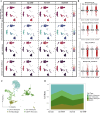Single-cell analysis reveals the spatiotemporal effects of long-term electromagnetic field exposure on the liver
- PMID: 40655943
- PMCID: PMC12245793
- DOI: 10.3389/fcell.2025.1579121
Single-cell analysis reveals the spatiotemporal effects of long-term electromagnetic field exposure on the liver
Abstract
Introduction: Artificial electromagnetic fields (EMFs) can impair the functions of several organs. The impact of long-term artificial EMF on the liver, the synthetic and metabolic center of the body, has become concerning. The aim of this study was to systematically evaluate the effect of long-term EMF exposure on the liver.
Methods: Mice were exposed to 2.45 GHz EMF daily for up to 5 months, and serum liver function test, lipidomic analysis, and histological analysis were performed to detect the general impact of EMF on the liver. Furthermore, EMF-induced liver transcriptome variations were investigated using single-cell RNA sequencing and a spatiotemporally resolved analysis.
Results: Different hepatic cells exhibited diverse sensitivities and response patterns. Notably, hepatocytes, endothelial cells, and monocytes showed higher sensitivity to electromagnetic radiation, with their lipid metabolic functions, immune regulation functions, and intrinsic functions disturbed, respectively. Moreover, transcriptomic alterations were predominantly observed in the hepatocytes and endothelial cells in peri-portal regions, suggesting a zonation-related sensitivity to EMF within the liver.
Conclusion: Our study provided a spatiotemporal visualization of EMF-induced alterations in hepatic cells, which ultimately elucidated the biological effects of EMF exposure.
Keywords: electromagnetic field; hepatic zonation; liver function; single-cell analysis; single-cell transcriptome.
Copyright © 2025 Zhang, Lv, Zhao, Zeng, Wu, Zhou, Xi, Pei, Wang, Li and Yue.
Conflict of interest statement
The authors declare that the research was conducted in the absence of any commercial or financial relationships that could be construed as a potential conflict of interest.
Figures






Similar articles
-
Determining the relationship between mobile phone network signal strength and radiofrequency electromagnetic field exposure: protocol and pilot study to derive conversion functions.Open Res Eur. 2025 Mar 31;4:206. doi: 10.12688/openreseurope.18285.2. eCollection 2024. Open Res Eur. 2025. PMID: 40291791 Free PMC article.
-
A Novel Design of a Portable Birdcage via Meander Line Antenna (MLA) to Lower Beta Amyloid (Aβ) in Alzheimer's Disease.IEEE J Transl Eng Health Med. 2025 Apr 10;13:158-173. doi: 10.1109/JTEHM.2025.3559693. eCollection 2025. IEEE J Transl Eng Health Med. 2025. PMID: 40657533 Free PMC article.
-
Possible effects of melatonin and omega-3 on the obesity-related hypothalamic nuclei of the electromagnetic field-exposed offspring rats: a stereological and immunohistochemical analysis.Front Public Health. 2025 Jun 25;13:1583097. doi: 10.3389/fpubh.2025.1583097. eCollection 2025. Front Public Health. 2025. PMID: 40636869 Free PMC article.
-
Radiofrequency electromagnetic field exposure in everyday microenvironments in Europe: A systematic literature review.J Expo Sci Environ Epidemiol. 2018 Mar;28(2):147-160. doi: 10.1038/jes.2017.13. Epub 2017 Aug 2. J Expo Sci Environ Epidemiol. 2018. PMID: 28766560
-
A review of the ecological effects of radiofrequency electromagnetic fields (RF-EMF).Environ Int. 2013 Jan;51:116-40. doi: 10.1016/j.envint.2012.10.009. Epub 2012 Dec 20. Environ Int. 2013. PMID: 23261519
References
LinkOut - more resources
Full Text Sources

